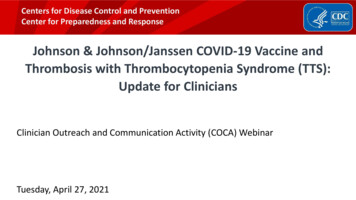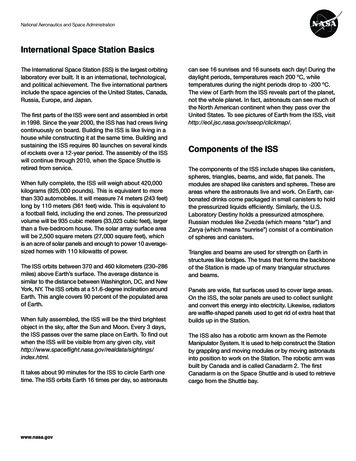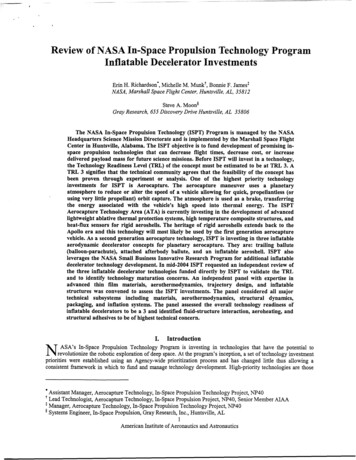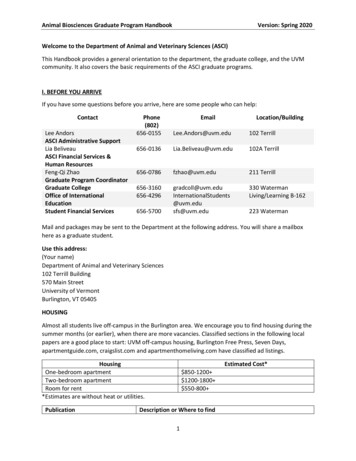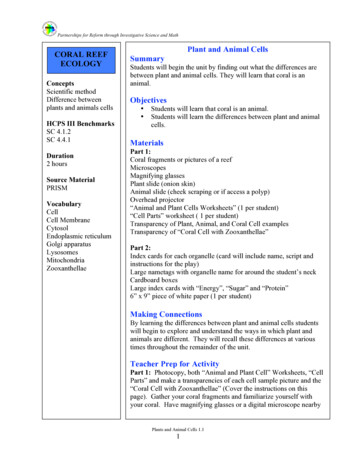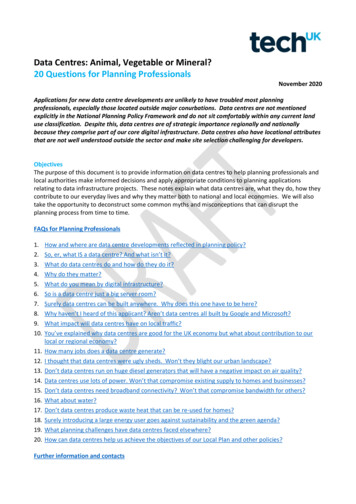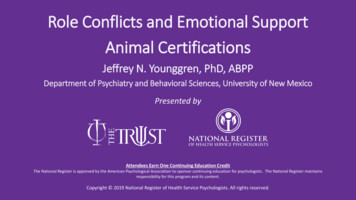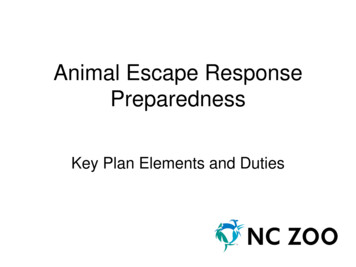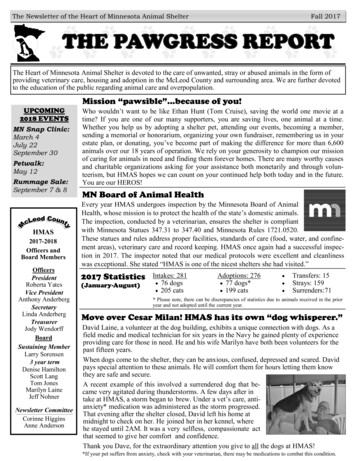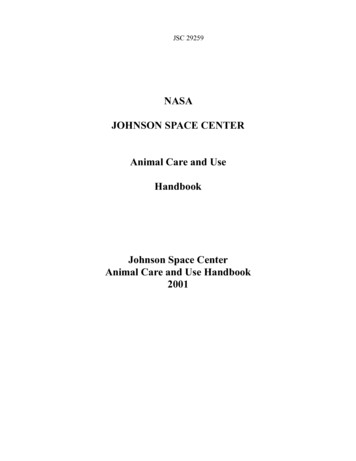
Transcription
JSC 29259NASAJOHNSON SPACE CENTERAnimal Care and UseHandbookJohnson Space CenterAnimal Care and Use Handbook2001
DateAuthor:APPROVAL SIGNATURESDarla Schmitt, ACF Lab AssociateJSC ACF Facility ManagerApprovers:John Boyd, M.S.Attending VeterinarianTerry Blasdel, D.V.M.NASA Chief VeterinarianMS211/Alex Dunlap, D.V.M.9DateDateCONCURRENCEWyle Toxicology Supervisor Thomas F. Limero, Ph.D.NASA, Director, Space andLife SciencesJSC IACUC ChairmanDavid R. Williams, M.D.John T. James, Ph.D.REVISION HISTORYRev. No.-Effective DateDescription of ChangeInitial ReleaseAuthor(s)D. Schmitt9
iPrefacePurpose of This HandbookA core of knowledge about the ethical and humane care and use of animals in instruction and researchis essential. Researchers, their staffs (including both permanent and temporary workers), contractors,subcontractors, grantees, and others who work with animals have an obligation to know about lawsgoverning the ethical concerns relevant to the care and use of animals and to be familiar with theguidelines and policies established by Johnson Space Center, scientific societies and othergovernment agencies.This Handbook is designed to help meet these obligations and to provide you with information aboutJohnson Space Center's Animal Care Facility, and the services offered.Johnson Space Center is committed to the ethical and humane care and use of animals and eachperson must share responsibility in meeting that commitment.AcknowledgmentWe thank our colleagues at other institutions that freely provided some of the material presented here.Persons in Laboratory Animal Science traditionally share information, published or unpublished,because we share the belief that the animals used in instruction and research are totally dependentupon us for their care and well-being.Much effort has been made to ensure that the information provided herein is accurate. If, however,errors of any kind are identified, please notify the Animal Care Facility Manager (281-483-2846) orthe Animal Care Facility Office (281-483-8800).This Handbook is considered a “living document,” subject to change in the light of new informationand changing conditions.
iiTABLE OF CONTENTS1 ACRONYMS AND DEFINITIONS . 1Public Health Service Policy on the Humane Care and Use of Laboratory. 6Animals (NIH Policy) l.htm). 6.5Animal Acquisition and Transfer.24All animal laboratories are considered controlled areas. Only individuals who have had theanimal handler's medical examination and the orientation program on experimental animalsare permitted in laboratories and the immediately surrounding areas when animals arepresent. 25The legal requirements for appropriate care and humane treatment of experimental animalsapply not only to animals housed in the ACF, but also to animals when they are inInvestigators' laboratories. Thus, in the laboratory, all of the requirements outlined in thismanual apply. 25Veterinary care is an essential part of an animal care program. Adequate veterinary careconsists of:. 44MICROBIOLOGICAL TESTING OF THE ACF. 50MICROBIOLOGICAL TESTING IS PERFORMED ANNUALLY BY THE WYLELABORATORIES MICROBIOLOGY LABORATORY IN BUILDING 37, ROOM 1022. THEFOLLOWING SAMPLES ARE ANALYZED:. 50APPENDIX B-6. 54BASELINE CARE AND HUSBANDRY CONDITIONS - RODENTS .54Standard Environmental Conditions for Rodents at JSC ACF. 54
iiiFIGURESFigure 1: Rodent Identification by Ear MarkingLIST OF APPENDICESAPPENDIX AAPPENDIX BAPPENDIX B-1APPENDIX B-2APPENDIX B-3APPENDIX B-4APPENDIX B-5APPENDIX B-6APPENDIX CAPPENDIX DAPPENDIX EAPPENDIX FAPPENDIX GAPPENDIX HSTATEMENT OF COMPLIANCEGENERAL CLEANING PROCEDURESOPERATION OF CAGE WASHERMICROBIOLOGICAL TESTINGCLEANING PROCEDURES FOR ANIMAL CAGESCONTROLLED SUBSTANCES/DRUG POLICYMEDICAL EXAMINATION FOR ANIMAL CONTACTBASELINE CARE AND HUSBANDRY CONDITIONSANIMAL USE PROTOCOLAPPLICATION FOR ACCESS TO JSC/NASA ANIMAL FACILITYPROCEDURE RECORDS/POST-OPERATIVE OBSERVATIONSANIMAL PROCUREMENT REQUESTMONITORING REPORT FOR REFRIGERATORS/FREEZERSCHEMICAL ORDER FORMTABLESOrganization ChartBuilding 37 Floor PlanAnimal Facility Floor Plan
i1 Acronyms and DefinitionsAAALACAssociation for the Assessment and Accreditation of Laboratory AnimalCare, InternationalAALASAmerican Association for Laboratory Animal ScienceACFAnimal Care Facility at NASA Ames Research CenterACLAMAmerican College of Laboratory Animal MedicineAPHISAnimal and Plant Health Inspection ServiceJSCAmes Research CenterAVMAAmerican Veterinary Medical AssociationAWICAnimal Welfare Information CenterCDCCenters for Disease ControlCFRCode of Federal RegulationsDEADrug Enforcement AgencyDOIDepartment of the InteriorEPAEnvironmental Protection AgencyFDAFood and Drug AdministrationGLPGood Laboratory PracticesGuide (the) NRC Guide for the Care and Use of Laboratory AnimalsHHSDepartment of Health and Human ServicesHVACHeating, Ventilation and Air ConditioningIACUCInstitutional Animal Care and Use CommitteeILARInstitute of Laboratory Animal ResourcesIOMInstitute of MedicineIRACInteragency Research Animal CommitteeJSCJohnson Space Center (Houston)KSCKennedy Space Center (Florida)NAENational Academy of EngineeringNALNASNIHNIH PolicyNational Agriculture LibraryNational Academy of SciencesNational Institute of HealthPublic Health Service Policy on the Humane Care and Use of LaboratoryAnimalsNPDNASA Policy DirectiveNPGNASA Policy GuideNRCNational Research CouncilNRC Guide NRC Guide for the Care and Use of Laboratory AnimalsNSFNational Science FoundationOLAWOffice of Laboratory Animal Welfare
iiOSHAPHSPHS ActPIPOCREACSDHSSOPUSDAWIOccupational Safety and Health AdministrationPublic Health ServicePublic Health Service Act (Public Law 99-158)Principal InvestigatorPoint of Contact IndividualRegulatory Enforcement and Animal CareState Department of Health ServicesStandard Operating ProceduresU.S. Department of AgricultureWork Instruction2 Ethics and the Care and Use of Animals at Johnson Space CenterJohnson Space Center recognizes this Handbook as a common point of referencein addressing ethical concerns within discussions, evaluations and theimplementation of all policies and procedures concerning the care and use ofanimals at JSC by all JSC investigators, their staffs (including both permanent andtemporary), contractors, subcontractors, grantees and others.JSC recognizes the legitimacy, importance and sensitivity of the public debateconcerning the ethics of animal care and use. We further recognize that within thisdebate there are a number of legitimate and responsible perspectives and manyunresolved issues. We recognize that legitimate concerns and views are expressedin various ways -- including the concept of animal rights and the consideration ofanimal use versus the significant enhancement of human and animal life. We,therefore, commit ourselves to be a respectful and responsible party within thison-going public debate.Our role in the care and use of animals carries the responsibility to effectivelymeet the needs of the animals in our charge while actively seeking and employingmethods that embody respect for the life of animals.1NASA Principles for the Ethical Care and Use of Animals (TheSundowner Report) October, 1996.2IntroductionOnly the strongest possible allegiance to principles of bioethics can offer asound basis for any discussion of responsible research. As reflected in theearliest considerations of the National Commission for the Protection ofHuman Subjects, "scientific research has produced substantial socialbenefits .[and] some troubling ethical questions" (The Belmont Report,1979). The Belmont Report identified fundamental principles underlyingthe ethical evaluation of research involving human subjects. Similarly, theprinciples governing the ethical evaluation of the use of animals inresearch must be made equally explicit.
iiiVertebrate animals deserve moral concern. The following principles areoffered to guide careful and considered discussion of the ethicalchallenges that arise in the course of animal research, a process that mustbalance risks, burdens and benefits. NASA will abide by these principlesas well as all applicable laws and policies that govern the ethical use ofanimals (see list at end). It is recognized that awareness of these principleswill not prevent conflicts. These principles are also not meant to prescribedefinite procedures for resolving such conflicts but rather to provide aframework within which challenges can be addressed in a rational manner.
iv2.3Basic PrinciplesThe use of animals in research involves responsibility for the stewardship of theanimals, and responsibility to the scientific community and society. Stewardshipis a universal responsibility that extends beyond the immediate use of the animalsfor research to include their acquisition, care and disposition while responsibilityto the scientific community and society requires an appropriate understanding of,and sensitivity to scientific needs and community attitudes toward the use ofanimals.Among the basic principles generally accepted in our culture, three areparticularly relevant to the ethics of research using animals: respect for life,societal benefit and nonmaleficence.2.1Respect for LifeLiving creatures deserve respect. This principle requires thatanimals used in research should be of an appropriate species andhealth status and should involve the minimum number required toobtain valid scientific results. It also recognizes that the use ofdifferent species may raise different ethical concerns. Selection ofappropriate species should consider cognitive capacity and othermorally relevant factors. Additionally, methods such asmathematical modes, computer simulation, and in vitro systemsshould be considered and used whenever possible.2.2Societal BenefitThe advancement of biological knowledge and improvements inthe protection of the health and well being of both humans andother animals provide strong justification for biomedical andbehavioral research. This principle entails that where animals areused, the assessment of the overall ethical value of such use shouldinclude consideration of the full range of potential societal goods,the populations affected, and the burdens that are expected to beborne by the subjects of the research.2.3NonmaleficenceVertebrate animals are sentient. This principle entails that theminimization of distress, pain and suffering is a moral imperative.Unless the contrary is established, investigators should considerthat procedures that cause pain or distress in humans may causepain or distress in other sentient animals.2.4Cited DocumentsBelmont Report, 1979Animal Welfare Act (Public Law 89-544 as amended)Government Principles for the Utilization and Care of VertebrateAnimals Used In Testing, Research, and Training, Developed byIRAC and endorsed by the Public Health Service Policy on theHumane Care and Use of Laboratory Animals, 1985
v3International Guiding Principles for Biomedical ResearchInvolving Animals, Developed by the Council for InternationalOrganizations of Medical Sciences, Switzerland, 1985Public Health Service Act (Public Law 99-158, 1985)Guide for the Care and Use of Laboratory Animals, 1996Responsibilities3.1Center DirectorThe Center Director is charged with the overall administrativeresponsibility for implementing and maintaining an institutional animalcare and use program to assure that all humane, ethical, and legalrequirements are met.3.2Institutional OfficialThe Director, Space and Life Sciences Office, has been delegated by theCenter Director to serve as the Institutional Official and is responsible forthe management of the Animal Care Facility except for signing andsubmitting the Animal Welfare Assurance to the Office of LaboratoryAnimal Welfare (OLAW). This responsibility has been retained by theJSC Center Director.3.3Director, Space and Life Sciences OfficeThe Director, Space and Life Sciences Office, is responsible for theoversight of the management of JSC Animal Care Facilities and all issuespertaining to the care and use of animals except as noted above.3.4Attending VeterinarianThe Attending Veterinarian will have delegated responsibility for thehealth of all animals involved in teaching, exhibition and research.3.5NASA Chief Veterinary OfficerThe Chief Veterinary Officer is responsible for coordinating veterinary andanimal care and use activities for all NASA facilities, including the SpaceShuttle and Space Station.6JSC Institutional Animal Care and Use CommitteeThe Institutional Animal Care and Use Committee (IACUC) is chargedwith developing, recommending and monitoring NASA-JSC policies andstandards relating to animal acquisition, care and use.
vi3.7.84Animal Care Facility OperationsThe Animal Care Facility staff is responsible for implementingprofessionally acceptable standards for the proper care and use of allanimals within all animal facilities, and assuring that those standards aremet and maintained.Investigator and StaffThe individual investigators, their staffs, contractors, subcontractors,grantees and others who are involved with the care and use of animals ininstruction and research (including field studies of live vertebrates) areexpected to study and review this Handbook and to acknowledge theiracceptance of the responsibilities therein.Individuals are accountable by law to comply with the rules andregulations of the applicable statutes. Individuals are also accountable toNASA-JSC to conform to the policies and guidelines adopted by thisInstitution. These regulations and policies cover: the acquisition, care and use of animals; efforts to minimize animal pain and distress; the training of personnel using animals; and consideration of alternatives to animal use.As a matter of educational policy, even personnel who do not themselvesuse animals should be aware of these regulations and policies since theirco-workers, staffs or others may use animals at a later time. Likewise,instruction of students in proper animal use is an essential component ofeducation in the sciences.Policies, Principles, Standards and Guidelines4.1U.S. Government Principles for the Utilization and Care of VertebrateAnimals Used in Testing, Research and Training htm#2b)The principles were developed by the U.S. Government's InteragencyResearch Animal Committee. Both Public Health Service (PHS) policyand NASA-JSC policy require that all research and instructional uses ofanimals conform to these Principles.2Public Health Service Policy on the Humane Care and Use of Laboratory
vii4.34.4Animals (NIH Policy) l.htm)The Public Health Service Policy on the Humane Care and Use ofLaboratory Animals (1986) incorporates the changes in the Public HealthService Act (PHS Act) mandated by the Health Research Extension Act of1985 (Public Law 99-158). The PHS Act (herein referred to as the NIHPolicy), frequently requires that each institution receiving PHS funds forresearch involving animals submit detailed information regarding theinstitution's program for the care and use of animals to the Office ofLaboratory Animal Welfare (OLAW). This information is in the form of anAnimal Welfare Assurance Statement, and it must be resubmitted at leastevery five (5) years. Significant changes in existing assurance status orproblems encountered in implementing this policy must be reportedimmediately to the OLAW. In addition, an annual report is submittedutilizing the form provided by OLAW.An institution's failure to comply with these policies may lead to variousactions, including the termination of PHS/NASA support for allprojectsinvolving animals.The NRC Guide for the Care and Use of Laboratory ts/)The purpose of the NRC guide is to assist scientific institutions in usingand caring for laboratory animals in ways judged to be professionallyappropriate.This guide is required reading for all managers, investigators and staffinvolved in the animal care and use program at NASA-JSC.NASA Policy Directive WIDE/Policies/Program Management/N PD 8910 1.html)The NASA Policy Directive details the policy of the National Aeronauticsand Space Administration regarding all animal-related activities. ThisNPD is based on provisions of the latest issues of the NRC Guide, on thePublic Health Service Policy on Humane Care and Use of LaboratoryAnimals, and on the Animal Welfare Act 89-544, 1966, as amended (PL91-579, 94-279, and 99-198) et. seq., 42 U.S.C. 2473(c)(1) of the NationalAeronautics and Space Act of 1958, as amended, and the Code of FederalRegulations (CFR) (9 CFR Subchapter A, Parts 1-4).
viii4.54.6NASA Policy Guideline (NPG)http://nodis.hq.nasa.gov/displayDir.cfm?t NPR&c 8910&s 1Ahttp://nodis.hq.nasa.gov/displayDir.cfm?t NPD&c 8910&s 1BThe NASA Policy Guideline delineates the implementing guidelines forthe Agency’s use of animals in research, testing, teaching and hardwaredevelopment activities, including such activities conducted in non-U.S.facilities and flight vehicles. This NPG applies to NASA Headquarters andNASA Centers, including Component Facilities, and will be followed byall individuals responsible for any activity involving animals funded by orsponsored by NASA; conducted in or on any NASA facilities, aircraft orspacecraft; or that involve NASA to any degree. Such activities includethose conducted under a cooperative agreement, or other arrangement oragreement, entered into by NASA and another Government agency,private entity, non-Federal public entity, or foreign entity.Independent Professional Organizations4.6.1 The American Association for Laboratory Animal Science(AALAS) (http://www.aalas.org)The American Association for Laboratory Animal Science(AALAS) is an organization composed of individuals andinstitutions professionally concerned with the husbandry, care, anduse of laboratory animals. It provides a means for the collectionand exchange of information on all phases of laboratory animalcare and management. The Association's Animal TechnicianCertification Board provides a means of developing uniformstandards for technician training by defining the qualifications,preparing and approving examinations for training programs, andcertifying successful candidates.2The Association for the Assessment and Accreditation ofLaboratory Animal Care (AAALAC), International is theorganization for voluntary peer-review accreditation of laboratoryanimal care facilities and programs. AAALAC judges animal careby the standards set forth in the NRC Guide for the Care and Useof Laboratory Animals. Inspections are made every 3 years byrepresentatives of this organization to ensure that the institutioncontinues to meet these standards. The NI
HVAC Heating, Ventilation and Air Conditioning IACUC Institutional Animal Care and Use Committee ILAR Institute of Laboratory Animal Resources IOM Institute of Medicine IRAC Interagency Research Animal Committee JSC Johnson Space Center (Houston) KSC Kennedy Space Center (Florida) NAE National Academy
